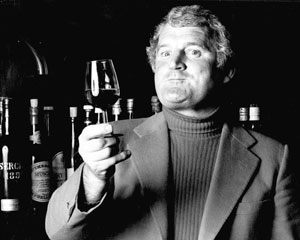
In Part 1, we discussed and introduced Max Schubert, the maker of Australia’s most iconic wine, “Penfolds Grange Hermitage”. Schubert was not alone in his quest to promote and make quality Australian wine.
Report by Mark Mair
Australia is probably the driest continent on earth, so any type of agricultural industry is going to be tough.
The making of a well-known brand, especially one which has become of great national significance, involves the coming together of several pieces of the jigsaw puzzle at the right time. Len Evans is one of those master jigsaw puzzle experts who saw the whole picture before he had even unpacked the pieces from the box.
This man, along with Max Schubert, is one of the most important individuals in the Australian wine industry.
Born in Felixstowe, England in 1930, Evans’ first occupation was that of a professional golfer. He emigrated to New Zealand in 1953 and then to Australia two years later, arriving in Sydney, where he held down a job at the Chevron Hilton Hotel, which was his stepping stone into a life devoted to the promotion of Australian wine. By 1965 he was the first national promotions executive for the Australian Wine Board.
Evans was one of the first people “in wine” of that era who saw the future in table wine, and not the fortifieds, which were what Australia specialised in at the time.
Being a natural raconteur (like all great salesmen who have the gift of phrase), Evans managed to convince a very tough Australian male population (The Ute driving, beer drinking, crocodile wrestling ones) that it was indeed manly to drink wine, and especially so if it was good Australian wine!
- Chamisa under fire over US$120K donation
- Mavhunga puts DeMbare into Chibuku quarterfinals
- Pension funds bet on Cabora Bassa oilfields
- Councils defy govt fire tender directive
Keep Reading
Since then, the consumption of table wine has become an increasingly more indulged portion of Australian social life and indeed the economy.
Even “the crocodile wrestlers” enjoy a good, well-balanced Chardonnay from the Hunter Valley these days!
By the time Evans left the Australian Wine Board in 1969, he was writing books on the subject and was in the process of starting up his own operation in the Hunter Valley, Rothbury Estate. He also established his own restaurant-cum-dining club at Bulletin Place near Sydney Harbour.
Further ventures into wine estate purchase followed in France and the Napa Valley in California, financed by his great friend Peter Fox. Evans was also instrumental in developing blind wine tasting almost to the level of competitive sport in Australia!
Being recognised as having a discerning palate, he was often asked to join wine tasting panels and he oversaw the creation of The Options Game, a blind wine tasting competition which sent all proceeds to charity.
He was also chairman of the judges of the wine tasting competition at the Sydney Show for many years. Peter Fox was tragically killed in an aircraft crash in 1981 and the Evans overseas wine empire collapsed. Evans retreated to his two Australian wine interests, Rothbury and Petaluman, outside Adelaide, where he was involved from inception. In 1996 Rothbury was taken over by Fosters.
Evans continued to write and commentate on Australian wine issues until his death in August 2006.
Another talented Australian winemaker, David Hohnen, was instrumental in developing New Zealand’s flagship wine, Cloudy Bay’s celebrated Sauvignon Blanc. Hohnen, owner of Cape Mentelle Vineyard in Western Australia, was introduced to New Zealand’s Marlborough Sauvignon Blanc by some visiting New Zealand wine makers in 1984.
Impressed, he embarked on a visit to the country in order to identify some possible sites to make wine, especially his personal favourite, Sauvignon Blanc. En route he met Kevin Judd, an Australian wine maker for Selaks, at the National Wine Show.
Hohnen was very impressed with Judd’s wines and immediately hired him as his wine maker in New Zealand, even before he had found a vineyard!
It came to pass that the maiden vintage of Cloudy Bay wine was made by Hohnen (with Kevin Judd sending instructions via telephone) at Corbans Gisborne Winery on the North Island. This wine won a gold medal at the 1986 Air New Zealand Export Wine Awards, and topped a wine magazine tasting of the world’s best Sauvignon Blancs held in London that year.
Cloudy Bay shot to international fame almost instantly and made such an impression that Veuve Cliquot took a 70% share in both Cloudy Bay and Cape Mentelle in 1990.
Today, they are owned by the French company Louis Vuitton Moët Hennesy. The influence of Australian wine and its makers had crossed the Tasman sea — and a hugely impressive crossing it was!







